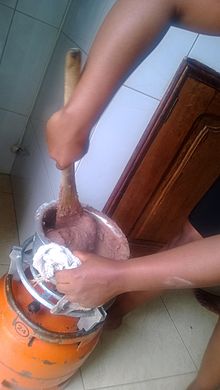Mujje Tulye from Uganda/A special dish of the Ankole tribe: the karo
Ankole
[edit | edit source]
Ankole is one of four traditional kingdoms in Uganda. It is located in southwestern Uganda, East of Lake Edward. It was ruled by a monarch known as The Mugabe. The kingdom was formally abolished in 1967 and is still not officially restored. The people of Ankole are called Banyankole (singular: Munyankole) in Runyankole language, a Bantu language.
Ankole is divided into ten districts, namely: Bushenyi District, Buhweju District, Mitooma District, Rubirizi District, Sheema District, Ntungamo District, Mbarara District, Kiruhura District, Ibanda District and Isingiro District.
Kalo (or karo) dish
[edit | edit source]
Kalo (or Karo) is a dish well known among the ethnic agrarian tribes in the western part of Uganda including the Bakiga, Banyankole, Batooro and Banyoro as well as some tribes from eastern Uganda including the Bagwere. However, some traditions have it that it originated from the tribes of northern Uganda during the Gipiiri and Labongo Luo migration before spreading southwards.
Millet flour is often not considered suitable for a meal unless cassava flour is added to it in a ratio of 1:3 to 1:5 (cassava flour:1 millet flour:5) by weight of millet. The reason is that millet on its own is not only coarse but it is also difficult to turn into a paste due to its 'stiff' reaction to water. The cassava element brings both a sticky and a soft texture, making the mixture relatively easy to prepare. However, others claim the introduction of cassava is due to modern efforts in trying to make kalo more appealing to the young generation as well as to people who traditionally did not appreciate it.
Kalo is extracted from dried millet grains either by using the traditional means of grinding with a smooth stone or using modern ways of a grain milling. After grinding, the millet is ready for making kalo. The cooking of kalo starts with boiling water (the amount of water used depends on the quantity of kalo one wants to cook. For example three litres of water to a kilo of flour). "With the water boiling in a pot, a handful of millet flour is sprinkled onto the water to create an initial reaction between the water and the flour. It reduces the air in the water, which interferes with the paste formation by creating hard particles. After the initial reaction, the water is reduced by a half to create space for the flour. The deducted water is put into a separate container. The flour swallows up the remaining water and forms a single bulging ball as it is stretched up. Often, more water is added. Cold water should not be used at this stage because the flour will become stiff. The actual mixing takes about 30 minutes depending on the amount of kalo to prepare. The kalo is ready when it turns elastic.
After mixing and squeezing the kalo into a dome, a basket matching the size of this dome is prepared. Raw flour is sprinkled onto the walls of the basket before the entire blob of kalo is hurled into the basket. The raw flour is meant to prevent the Kalo from sticking onto the basket's walls.
After cooking, it is good to leave the kalo covered up for 10-15 minutes before serving so that it tastes tender. In a family setting in Ankole, there is a special basket (endiiro) used by the head of the family and other baskets for the rest of the family members. In other settings, sliced pieces of kalo are held in one hand and one keeps pulling off a small piece, moulding it, using a thumb to make a hole in this piece to accommodate the sauce and then dipping it into the sauce.
The dish is often a must for many traditional ceremonies such as child naming or marriage.
Ingredients
[edit | edit source]



- Boiling water
- Millet flour
- Cassava flour
Preparation process
[edit | edit source]Preparation of a traditional meal (karo) of Ankole culture in western Uganda
- Mix the millet flour and cassava flour in a ratio of three to one respectively (or buy pre-mixed flour)
- Put water in a pan and let it boil.
- While it boils, add the flour as you mingle.
- Continue mingling till it gets ready (the karo will not be sticking to the mingling stick at this point)
Serving
[edit | edit source]The karo is usually served with Eshabwe, a sauce (with beans or beef) and leafy greens along with water or a glass of fruit juice.
Eshabwe (ghee sauce)
[edit | edit source]
Eshabwe is a class of clarified butter that originated in Ankole and is commonly used as condiment. Eshabwe, also known as ghee sauce, is a traditional dish prepared in Ankole. The dish is usually prepared for special ceremonies or occasions.
Eshabwe is served as a condiment with the main course meal e.g. karo (milletbread), potatoes, matooke, beans and others.
Ingredients
[edit | edit source]- Ghee
- Rock salt
- Cold water
- Salt
Preparation
[edit | edit source]Initially ghee is washed clean in cold water. A mixture of rock salt and water (rwabarire) is added to the ghee. The mixture is stirred until the ghee changes from yellow to white in color. While adding cold boiled water, which has salt dissolved in it. The formed eshabwe is stirred until you get the desired thickness. After the eshabwe is formed, it is sieved to remove particles or impurities. Eshabwe is served with any main course meal e.g. millet bread, matooke, sweet potatoes etc.